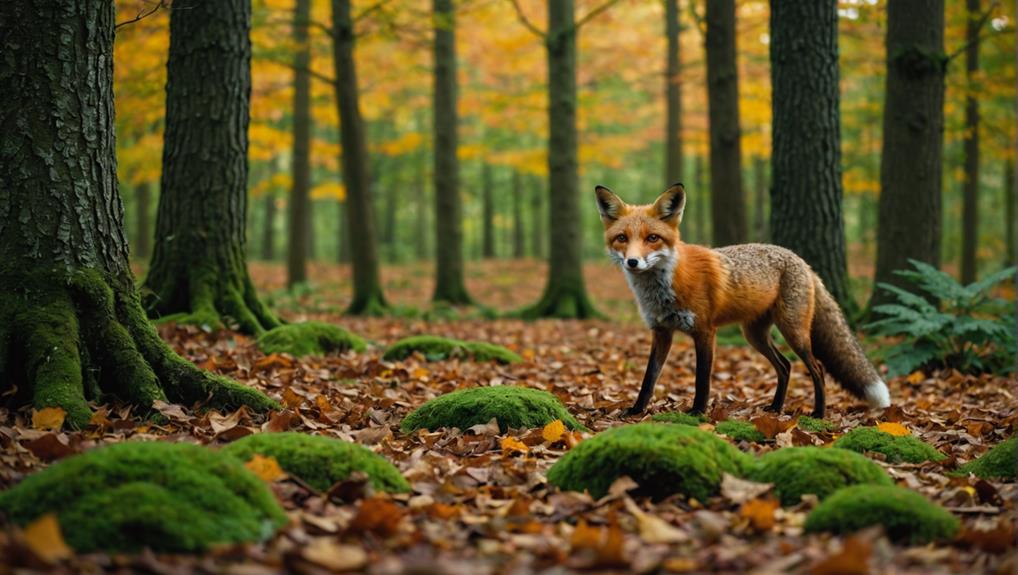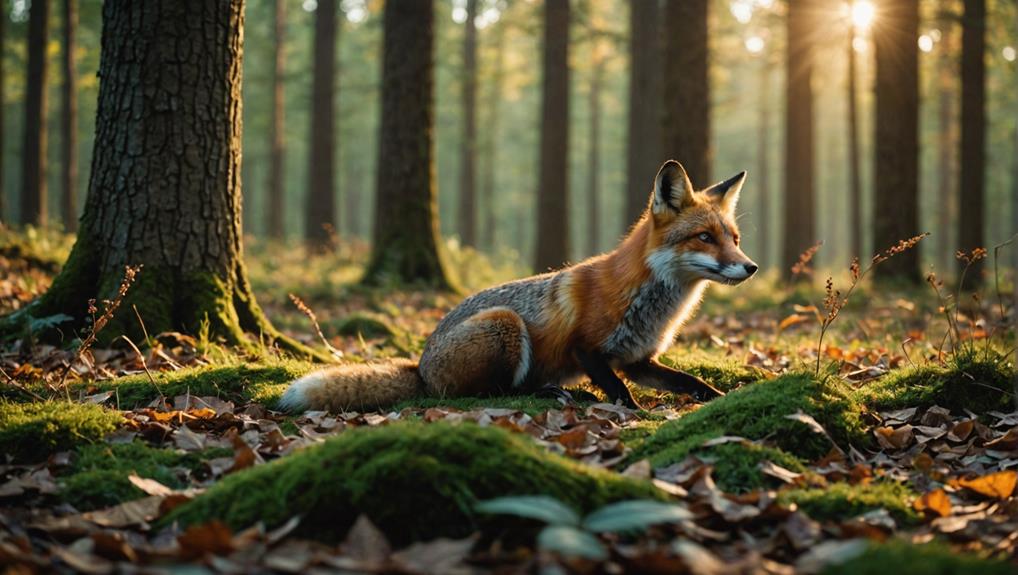Foxes usually munch on their meals about once or twice a day, but it really depends on their species, environment, and the season. For instance, urban foxes often snack on human leftovers, while their wild cousins hunt small mammals or forage for fruits. In spring and summer, they enjoy a more varied diet, while winter might have them scavenging more. Adult foxes typically need around a pound of food daily, but that can change with cubs or pregnant females. So, there's more to their dining habits, and you might just find some surprising facts ahead!
Contents
Diet Variability Among Fox Species
When considering the diets of different fox species, you'll notice significant variability that reflects their adaptations to diverse environments. Foxes are omnivores, which means their diet can change based on what's available.
Take Red Foxes, for instance; they enjoy a mix of small mammals, birds, and even fruits. Their adaptability allows them to thrive in various habitats, including urban environments where they often scavenge through human food waste for additional resources urban environments. They've got a diverse diet that helps meet their nutritional needs, no matter the season.
Urban foxes, on the other hand, have their own unique eating habits. They often scavenge through human food waste, adapting their hunting strategies to this new food source. It's fascinating how they'll munch on leftovers when food is scarce in the wild.
Fennec foxes stick to insects and small mammals, using their keen hearing to detect prey in the desert. Meanwhile, Arctic foxes primarily feast on lemmings, but they're flexible enough to grab marine life when it's cold and tough out there.
Each species showcases its own clever ways to survive. So, whether they're in the city or the wild, foxes have a knack for finding the right bite! Isn't that amazing?
Feeding Patterns and Behavior
Foxes exhibit fascinating feeding patterns and behaviors that reflect their adaptability and resourcefulness. You might find it interesting that these clever creatures typically munch on about 0.5 to 1 kilogram of food daily.
Their feeding habits can really change with the seasons. For instance, in the colder months, they often rely on scavenging, while in spring and summer, they enjoy a more varied diet that includes fruits and berries.
Urban foxes, like the red foxes that have thrived in cities, have adapted to utilize flexible diets that allow them to scavenge from human food sources, and sometimes racking up nearly 9,554 kcal weekly! That's a lot of leftovers! They're not picky eaters either; whether it's small mammals, eggs, or even some tasty scraps from your trash, they'll take what they can get.
With a keen sense of smell, foxes patrol their territories at night, honing their hunting skills. This nocturnal behavior increases their chances of finding food, and it's fascinating to watch how they adapt to their environment.
Seasonal Dietary Changes

Throughout the year, foxes shift their diets to take advantage of seasonal food sources. In spring and summer, you'll find them feasting on a variety of small mammals and birds, insects, and even fruits and berries. This variety allows for a more balanced and varied diet, which is essential for their health.
As Arctic foxes exhibit advanced hunting skills, they use their keen hearing to detect prey beneath the snow, which can be advantageous during these warmer months. As autumn rolls in, those delicious fruits and berries become even more significant. Foxes munch on these sweet treats to fatten up for the harsh winter months ahead.
When winter arrives, things get trickier. Food resources dwindle, so foxes often rely on scavenging more than hunting small prey. Their primary food source, like small mammals, can be hard to find during this time.
If you live in urban areas, you might notice these clever creatures foraging through human food waste, adapting their diets based on what's available. This adaptability is crucial, especially during the winter breeding season when their energy needs are heightened.
Seasonal variations in prey and scavenged items directly impact their nutritional intake, reminding us just how resourceful these little critters can be!
Energy Requirements and Intake
Understanding the energy requirements of foxes is crucial for grasping their dietary habits. These small, cunning creatures have specific needs that change with the seasons. In winter and spring, adult foxes typically require about 454 grams (1 lb) of meat daily. That's roughly 10% of their body weight!
Here's a quick glance at their energy needs:
| Type of Fox | Daily Food Intake |
|---|---|
| Adult Foxes | 454 grams (1 lb) |
| Cubs (3 months old) | 440 grams (just under 1 lb) |
| Pregnant Vixens | 700 grams (1.5 lbs) |
Their energy needs can vary, especially in autumn when male foxes may need 28% more than females. Cubs start with a modest food intake of around 130 grams daily, but they grow fast! As for locating food, they often hunt live prey, making reasonable feeding essential. In captivity, these needs can soar, but the wild foxes manage their meals quite well. Understanding these energy dynamics helps us appreciate the intricacies of a fox's diet and their survival in different environments.
Urban vs. Wild Fox Diets

When you observe foxes in urban settings, you might notice their diets look quite different from those living in the wild. Urban foxes often depend on human food waste, scavenging from dustbins and snatching up whatever they can find. They rely heavily on pet food, making their meals way more varied than their wild counterparts.
On the other hand, wild foxes focus on hunting small mammals, birds, and insects, while also foraging for fruits and vegetables in their natural habitats.
Interestingly, urban areas can support larger groups of foxes because of the easy access to human food sources. This leads to some significant dietary differences.
Studies show that urban foxes can consume about 40 MJ weekly from our leftovers, while wild foxes have to work harder, relying on hunting and foraging, which is often more energy-intensive.
Although both types of foxes have similar caloric needs of about 470 kcal a day, their food sources are worlds apart.
Urban foxes get around 1 MJ daily from human interactions, while wild foxes stick to their natural prey.
Final Thoughts
So, next time you spot a fox, remember they munch on a wide range of foods, from fruits to small critters, depending on their surroundings. Did you know that a fox can eat up to 2 pounds of food in a single day? That's like gobbling down a big pizza all by yourself! Whether they're prowling through the woods or sneaking through your neighborhood, these clever creatures always find a way to satisfy their hunger.














